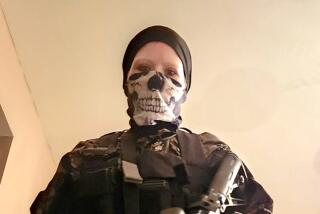Reassurances for Anxious Nation
- Share via
WASHINGTON — A week after declaring a high-level security alert, President Bush sought to reassure the nation Friday, but law enforcement officials expressed growing anxiety about their ability to track hundreds of Al Qaeda sympathizers in the United States.
“We’re trying to protect you. We’re doing everything in our power to make sure the homeland is secure,” Bush said in a speech at FBI headquarters, where he was joined by Atty. Gen. John Ashcroft, Homeland Security Secretary Tom Ridge and FBI Director Robert S. Mueller III.
As Bush announced a new joint counter-terrorism venture by the FBI and CIA, officials said that they have identified 600 to 1,000 potential Al Qaeda terrorists in cells around the U.S., but that only a fraction appeared to be hard-core.
One U.S. intelligence official, meanwhile, confirmed that the reams of intelligence reports that sent alarm bells ringing over the last few weeks included some references to particular targets. “They have named certain places,” said Sen. John D. “Jay” Rockefeller IV of West Virginia, the ranking Democrat on the Senate Intelligence Committee. He referred to warnings regarding the “East Coast, West Coast and Southwest,” but he would not elaborate.
Authorities have also said that most “intel” reports have been almost impossible to decipher, with veiled references to “packages” and other items that may, in the end, be harmless. But some referred to chemical and biological weapons and so-called dirty bombs, or low-level radioactive materials wrapped around conventional explosives, the officials said.
“We know that we have people here and out there that want to kill us, and we know that many of them are in the United States, but we don’t know where they are,” said one senior counter-terrorism official. “So you put that together with all of the intel, it scares people” within the FBI and state and local counter-terrorism agencies.
“You can read a lot into this,” the official said of the intelligence reports, which have been gleaned from efforts to monitor Al Qaeda cells around the world. “But it doesn’t give you the detail everyone wants.”
FBI officials also acknowledged Friday that at least one suspected terrorist in custody fabricated information about potential attacks. The detainee’s remarks were one factor in raising the threat advisory to code orange, signifying a “high risk” of terrorist attack, but they were not a major factor, the officials said.
Ridge also said Friday that the intelligence reports were too vague to act on.
“We assess all of the available information several times a day. But I would like to remind everyone again that the information we have to work with, more often than not, is very vague,” Ridge said during a speech at the new Homeland Security offices.
He said that there were no plans to increase or lower the alert level, and that federal, state and local authorities and the private sector have all taken protective measures to prevent a terrorist attack from occurring.
A senior FBI official said the bureau has no standard policy in place in its 56 field offices on how to deal with the new intelligence.
For the most part, each determines how to monitor potential terrorist cells within its jurisdiction, working with state and local authorities and prosecutors who are members of joint terrorist task forces, the official said.
“Is there a cell here, similar to [the] 9/11 [cell]?” asked another FBI official. “Are there individuals here who are sympathetic to Al Qaeda or other terrorist organizations? We know there are sympathizers out there. How many? We don’t know.”
The official noted that as many as 80,000 Muslim men attended Al Qaeda training camps in the 1990s and that many returned to the U.S. and remained sympathetic to Al Qaeda.
In some cases, the flurry of intelligence that prompted the government to raise the terrorist threat level pointed to certain targets in the United States, according to Rockefeller and other intelligence officials.
The threats prompted defensive measures around certain locations -- other than in New York and Washington -- that officials declined to identify.
Rockefeller also indicated that intelligence officials have expressed concern about certain “soft targets” -- buildings or sites considered vulnerable because they lack the fortified defenses of government facilities, military bases or U.S. embassies.
“Have they named a soft target or so? Yes,” he said. Rockefeller added, however, that the intelligence is “not conclusive,” meaning that it was not corroborated in such a way to warrant publicly identifying those targets.
Another intelligence official confirmed that account, calling such information specific enough to spur concerns about a number of sites in the U.S. In some cases, federal or local authorities expanded security and took other precautions to protect possible targets, which the official wouldn’t identify.
Bush, in his first speech at the FBI since shortly after Sept. 11, disclosed details of a plan to merge the counter-terrorism units of the FBI and the CIA. The agencies were criticized for missing warning signs of the attacks.
The Bush plan amounts to a compromise, with the two units soon to relocate under a new roof to ease the sharing of data.
Bush also called for creating a a database of known and suspected terrorists that officials across the country will be able to access and act upon.
More to Read
Sign up for Essential California
The most important California stories and recommendations in your inbox every morning.
You may occasionally receive promotional content from the Los Angeles Times.













